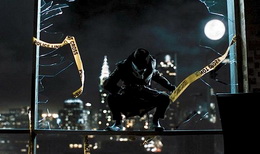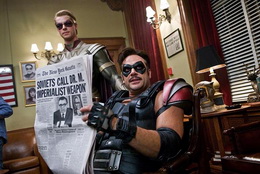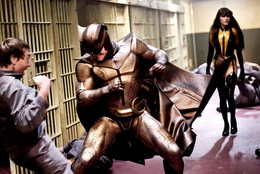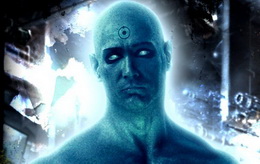
Watchmen reduces themes, expectations
Director Zack Snyder’s adaptation of the revered 1986-87 graphic novel “Watchmen,” written by Alan Moore and illustrated by Dave Gibbons, is like the ever-changing mask of its best-drawn character, Rorschach. Paced at many variable speeds, “Watchmen” is the most wildly inconsistent film I’ve seen in recent memory. In fact, the movie is so uneven that it sometimes it feels like parody or a gaudy recreation just minutes after achieving some kind of true cinematic bliss.
If only those blissful scenes were more prevalent in this 163-minute movie–a rare film that feels too long because of its awkward pacing and at the same time too short because it seems like there’s a ton of story missing.
Well, at least we had time for plenty of Snyder’s now-signature melodramatic slow-motion shots.
 Let me back up. I did a foolish thing. I read “Watchmen” just this past week, right before seeing the movie. I knew that comparison would be inevitable and that it would cloud my ability to evaluate the film on the film’s merit alone, but I just couldn’t help myself. I hadn’t read it in 10 years and I got excited–kind of like Dan Dreiberg putting on that old Nite Owl suit again.
Let me back up. I did a foolish thing. I read “Watchmen” just this past week, right before seeing the movie. I knew that comparison would be inevitable and that it would cloud my ability to evaluate the film on the film’s merit alone, but I just couldn’t help myself. I hadn’t read it in 10 years and I got excited–kind of like Dan Dreiberg putting on that old Nite Owl suit again.
Wait, let me back up again.
“Watchmen” the 12-issue comic-series-turned-classic-graphic-novel is a literary rumination about many things–the bestial nature of humans, the hunger for power and its consequences, the inevitability of time, the question of destiny, and the psychology of what it might take to make someone put on a silly costume and go out and fight crime. The book asks what motivates one to be a hero and comes up with myriad reasons across the psychological spectrum–very few of them pretty.
 “Watchmen” the movie recreates the purple, red, and yellow hues of the book’s alternate-reality 1985 and ramps up its very few action scenes to ridiculous levels while trying to stuff as much of the comic’s dialogue into the mouths of its characters as possible. Unfortunately, this approach doesn’t do the complicated tale any favors. Snyder’s movie is too tidy and reduces these lofty ideas to the kind of typical sentiment that he probably thought would be easier to swallow for an audience of the uninitiated.
“Watchmen” the movie recreates the purple, red, and yellow hues of the book’s alternate-reality 1985 and ramps up its very few action scenes to ridiculous levels while trying to stuff as much of the comic’s dialogue into the mouths of its characters as possible. Unfortunately, this approach doesn’t do the complicated tale any favors. Snyder’s movie is too tidy and reduces these lofty ideas to the kind of typical sentiment that he probably thought would be easier to swallow for an audience of the uninitiated.
It’s too bad, really, because with an opening-credit sequence as inspired as the one he’s concocted, the audience is hooked immediately and probably didn’t need to be talked down to. This bravura scene has its roots in the images of Gibbons’ intricately rendered 1940s costumed adventurers, but ironically, it is one of very few moments that don’t come directly out of the graphic novel. Snyder places us in the “Watchmen” reality by showing the rise and fall of costumed heroes through a series of stunning virtual freeze-frames of actual U.S. history (V-J Day, moon landing, JFK’s assassination) that have been altered by the presence of these costumed freaks. It is all rendered in super slo-mo and set to Bob Dylan’s “The Times They Are A-Changin’.”
In the movie’s 1985, the U.S. and U.S.S.R. are racing towards mutual nuclear destruction and Richard Nixon has repealed term limits to remain in the White House. Paranoia was amplified by the time period in which the book was released, and it’s a bold move by screenwriters Alex Tse and David Hayter to retain that notion today. Since that choice was made then, why wasn’t the choice also made to keep the actor doing the worst Nixon impression I’ve ever seen off the screen altogether? A silhouette and the man’s voice would have sufficed, but instead Snyder yanks his audience right out of that magical opening scene by giving us a poor Nixon caricature with a nose more fake than Michael Jackson’s.
 From there, we learn of a possible plot to kill superheroes (I hope “The Incredibles” paid Moore some kind of royalty back in 2004!) from an angry little cuss named Rorschach (Jackie Earle Haley) who narrates in a menacing growl that would make Clint Eastwood jealous. He’s on a mission to warn his fellow outlawed adventurers, including the rich and famous businessman Ozymandias (Matthew Goode), the nebbish Nite Owl (Patrick Wilson), the young and pretty Silk Spectre (Malin Akerman), and her otherworldly boyfriend Dr. Manhattan (Billy Crudup), the only person on the planet with actual superpowers.
From there, we learn of a possible plot to kill superheroes (I hope “The Incredibles” paid Moore some kind of royalty back in 2004!) from an angry little cuss named Rorschach (Jackie Earle Haley) who narrates in a menacing growl that would make Clint Eastwood jealous. He’s on a mission to warn his fellow outlawed adventurers, including the rich and famous businessman Ozymandias (Matthew Goode), the nebbish Nite Owl (Patrick Wilson), the young and pretty Silk Spectre (Malin Akerman), and her otherworldly boyfriend Dr. Manhattan (Billy Crudup), the only person on the planet with actual superpowers.
The movie poster claims that Snyder is the “visionary” director behind “300,” but the movie itself soon proves that only that he’s a first-rate visual stylist who fetishizes “cool.” What sets Rorschach off is the murder of an amoral government-sponsored “mask” named The Comedian (Jeffrey Dean Morgan). In one of a seemingly infinite number of slo-mo fight scenes with amped up sound effects, he is beaten to a pulp for a good long time before being thrown out the window.
The problem is that by swooping the camera around and dwelling on every painful punch (even one through a tile wall), Snyder is engaging in violence for purely prurient interests. Rather than deconstructing the superhero myth, he is merely glorifying the carnage. This is antithetical to the entire idea of realizing costumed adventurers as actual people, and is especially hard to take when an unexpected alley mugging is an excuse for Snyder to have some bone-snapping fun at his characters’ expense. Rather than showing the consequences of violence, Snyder is fetishizing it like he did in “300.”
 Snyder’s efforts to make “Watchmen” a commercial property make sense from a business standpoint (I’m the first to congratulate him for finishing a project that Terry Gilliam, Paul Greengrass, and Darren Aronofsky couldn’t finish.) Upping the action and violence factor certainly helps jar the viewer every now and then during the movie’s long 163 minutes, but doing that also sells out the point of the tale.
Snyder’s efforts to make “Watchmen” a commercial property make sense from a business standpoint (I’m the first to congratulate him for finishing a project that Terry Gilliam, Paul Greengrass, and Darren Aronofsky couldn’t finish.) Upping the action and violence factor certainly helps jar the viewer every now and then during the movie’s long 163 minutes, but doing that also sells out the point of the tale.
That’s not the only element that breaks any sort of psychological realism the film might have built up. Snyder doesn’t know how to handle his actors. One minute they are delivering dialogue that sounds like it was ripped from the pages of a “Star Wars” prequel and the next minute it all feels like a parody; like he’s messing with us on purpose. Bland performances from Akerman and Morgan don’t help, but most of all what is missing from the acting is any sort of consistency (with the exception of Haley and Crudup). There are even some very minor roles that turn out to be essential parts of the movie, and many of those actors seem like they could have been better handled by Ed Wood. (I’m speaking specifically, for example, about the last scene in the movie.)
Snyder may find it hard to handle dialogue or actors with any sort of subtlety, but he sure is great with montages. The other amazing scene in “Watchmen” is Dr. Manhattan’s origin story. The naked man who glows blue is human only in form. He experiences his own past, present, and future. For him, time doesn’t proceed forward sequentially like a movie, but rather all at once. It can be experienced in any order he chooses, like reading a two-page spread of comic book panels. Snyder flashes forward and backward through Manhattan’s life with precision, appropriating two beautiful pieces from Philip Glass’ “Koyaanisqatsi” soundtrack and featuring a calm narration from Crudup. These uniting forces keep the sequence together, giving the audience a taste of how it feels if all moments are the same moment. The God-like being’s remoteness from the world–his disconnect with all things human–become real. It’s a true “movie magic” scene–so much so, in fact, that when it’s time later for a pivotal moment where Manhattan’s mind must change for good, it’s bungled and unconvincing.
 One scene that may rub some people the wrong way (mostly because with all the varied tones in the movie, the audience doesn’t know how to take it) is a love scene that starts with the heroes wearing their costumes. It’s filmed with a little Skinemax-style soft focus and is a purposefully funny moment, culminating in a giant flamethrower ejaculation.
One scene that may rub some people the wrong way (mostly because with all the varied tones in the movie, the audience doesn’t know how to take it) is a love scene that starts with the heroes wearing their costumes. It’s filmed with a little Skinemax-style soft focus and is a purposefully funny moment, culminating in a giant flamethrower ejaculation.
Part of the appeal of the book was as much about the method of storytelling as it was the story. Numerous parallel stories commented on the unfolding narrative of the costumed adventurers. Many of those characters will be edited in later for a longer DVD cut, but their omission is not just felt by me as a fan of the graphic novel. Cutting out the characters on the New York street corner removes a great deal of the feeling of doom that should hang over the movie. Instead of experiencing the impending terror through their characters, we get newsreaders and politicians making speeches on TV and the old faithful ticking-clock device, here renamed the Doomsday Clock.
Again, Snyder is a visual stylist. The hollow simplicity of “300” was a tableau for him to show off his affectation for slow-motion violence and highly saturated colors. With “Watchmen,” however, the director is saddled with one hell of a complicated story. And he can’t handle it. It’s as simple as that. He benefits greatly from the source material in the sense that the compelling ideas in his movie are mostly from the graphic novel. And in the movie, they are still compelling (that is, when he’s not watering them down because he thinks “we can’t handle the truth!”).
What makes the “heroes” of “Watchmen” so interesting is that they hold down opposite philosophical ends of the spectrum. The book offers no answers, just a lot of questions. The movie, on the other hand, takes a stab at being an ordinary “nothing is more complicated than the human heart” story. Even in that respect, it doesn’t quite work.
Or at least that’s what I thought after one viewing. I’ll report back after seeing it again this weekend.

